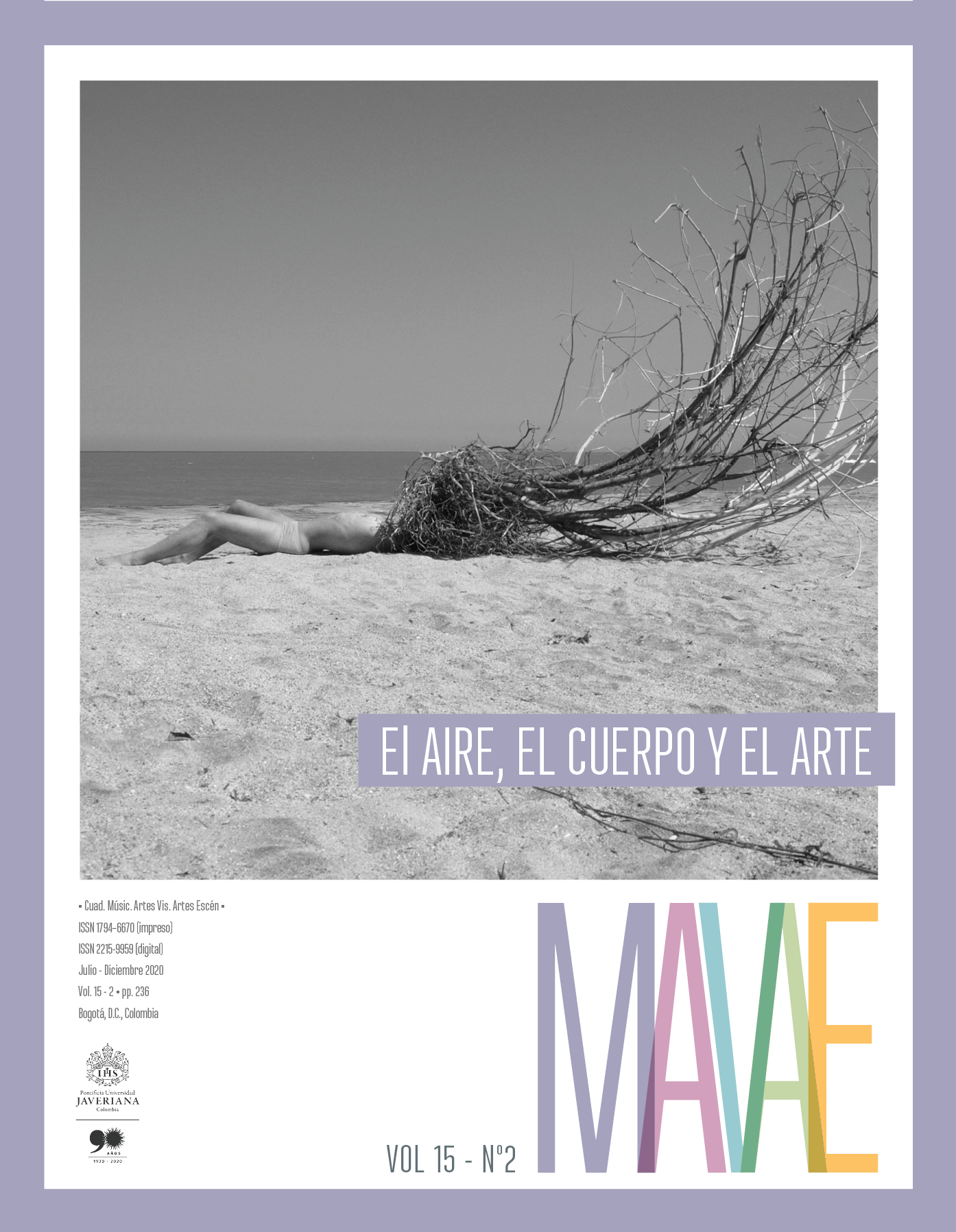Resumen
La obra de fotorreporteros africanos ha seguido siendo estudiada como mero registro documental o como medio de representación de una identidad nacional poscolonial supuestamente definida. Este artículo se distancia de esa lectura y muestra que George Osodi articula el testimonio, el documento, la ficción y la imagen poética en “imágenes pensantes” que ponderan algunas dinámicas y tensiones ecológicas del delta del Níger, una de las regiones más bio- y etnodiversas, y de mayor explotación petrolera del mundo. Para ello, el artículo asume una interpretación formal y contextual a la serie Oil Rich Niger delta (2003-2007), que, en diálogo con elementos de la historia de esta nación y región petrolera y con referentes de la tradición oral, la poesía y la ecocrítica, entiende el aire como tema y actante en una amplia red ecológica de humanos y no humanos, y como recurso metafórico con el que Osodi indaga algunas de las complejas tensiones ecológicas y una nueva cosmología del delta. Con énfasis en el aire como metáfora y como elemento actante, se muestra cómo Osodi rompe con la idea de que el fotorreportaje africano es principalmente antropocéntrico y cómo trabaja meticulosamente conexiones entre humanos y no humanos parte de un rico ensamblaje social en el que el fotógrafo da dignidad a actantes y actores.
Bachelard, Gastón. 1966. Psicoanálisis de fuego. Madrid: Alianza.
Bachelard, Gastón. 1993. El aire y los sueños. México: Fondo de Cultura Económica.
Bayelsa State Union. 2019. “What is Egbesu?”. Consultado: 20 de septiembre de 2019. https://web.archive.org/web/20121014192943/ http:/www.bayelsa.org.uk/main/what-isegbesu/
Bhabha, Homi, ed. 1990. Nation and Narration. Londres: Routledge.
Bueger, Christian y Jan Stockbruegger. 2017. “Actor-Network Theory: Objects and Actants, Networks and Narratives”. En Technology and World Politics: An Introduction, editado por Daniel R. McCarthy, 42-59. Abingdon: Routledge.
Caminero-Santangelo, Byron. 2014. Different Shades of Green: African Literature, Environmental Justice, and Political Ecology. Charlottesville: University of Virginia Press.
Ce, Chin. 2008. “Introduction: The Art of Younger Poets”. En New Voices: A Collection of Recent Nigerian Poetry, editado por Gloria Monica Emezue, 15-39. Garcena: The African Books Network.
Clark, John Pepper. 2020. “Night Rain”. Consulta: 31 de marzo de 2020. https://allpoetry.com/poem/10602495-Night-Rain-by-John-Pepper-Clark
Crayford, Steven. 1996. “Ogoni Uprising”. Africa Today 43 (2): 183-197.
Echandi, Marcela. 2004-2005. “El aire como elemento fundamental de la
imaginación en el aire y los sueños de Gaston Bachelard”. Revista Estudios 18-19: 95-103.
Festac ’77 Visitors Guide to the Festival. 1977. Lagos: International Secretariat.
Gaunt, Philip. Festac ’77 - Festival de Lagos. 1977; Unesco TV/Nigerian National Broadcasting Commission, 1997.
Gouveia, Sara de. (Counter) Festac ’77 ’77. 2014; Cape Town: Chimurenga, 2016.
Habila, Helon. 2011. Oil on Water. New York: W. W. Norton & Company.
Hawkes, Terence. 1977. Structuralism and Semiotics. Berkeley: University of California Press.
Iheka, Cajetan. 2018. Naturalizing Africa: Ecological Violence, Agency, and Postcolonial Resistance in African Literature. Cambridge: Cambridge University Press.
Kaplan, Flora Edouwaye S. 2008. “Idia, Queen Mother”. En The Oxford Encyclopedia of Women in World History. Vol 1: Abayomi-Czech Republicb, editado por Bonnie G. Smith, 527-528. Oxford: Oxford University Press.
LaGamma, Alisa. 2012. Heroic Africans: Legendary Leaders, Iconic Sculptures. Nueva York: The Metropolitan Museum of Art.
Latour, Bruno. 2005. Reassembling the Social: An Introduction to Actor-Network Theory. Oxford: Oxford University Press.
Loomba, Ania. 2005. Colonialism/Postcolonialism. Londres: Routledge.
Malinowski, Bronisław. 1948. Magic, Science and Religion and other Essays. Boston: Beacon Press.
Mbiti, John. 1977. “African oral Literature”. En Festac ’77, 96-97. Lagos: Africa Journal Limited/International Festival Committee.
NOSDRA (National Oil Spill Detection & Response Agency). 2019. “Nigerian Oil Spill Monitor”. Consultado: 1 de agosto de 2019.
https://nosdra.gov.ng
OPEC (Organization of the Petroleum Exporting Countries). 2019. “Nigeria Facts and Figures”. Consultado: 20 de septiembre de
2019. https://www.opec.org/opec_web/en/about_us/167.htm
Ogoni Youth Network. 2019. “Ogoni Bill of Rights”. Consultado: 12 de octubre de 2019. shorturl.at/kqJQ5
Ojaide, Tanure. 2006. The Activist. Lagos: Farafina.
Ojaide, Tanure. 2012. Stars of the Long Night. Lagos: Malthouse Press.
Ojaide, Tanure. 2015. The Tale of the Harmattan. Ibadan: Kraft Books.
Onwuachi, P. Chike. 1977. “African Identity and Ideology”. En Festac ’77, 16- 17. Lagos: Africa Journal Limited/International Festival Committee.
Okpewho, Isidore. 1993. Tides. Londres: Longman.
Oriji, John N. 2009. “Transformations in Igbo Cosmology during Slavery: A Study of the Geneses of Place-Names, Totems & Taboos”. Cahiers d’études africaines 196: 953-967.
Okonta, Ike y Oronto Douglas. 2001. Where Vultures Feast: Shell, Human Rights and Oil in the Niger Delta. San Francisco: Sierra Club.
Osodi, George. 2003-2007. “Oil Rich Niger Delta”. Consultado: 2 de septiembre de 2019. https://georgeosodi.photoshelter.com/index
Paoletti, Giulia. 2009. “Review: Paradise Lost: Revisiting the Niger Delta”. African Arts 42: 80-88.
Peter, Magelah. 2007. “Totem”. Consultado: 21 de mayo de 2007. https:// editors.eol.org/eoearth/wiki/Totem_(Environmental_ %26_Earth_Science)
Radcliffe-Brown, Alfred. 1952. Structure and Function in Primitive Society. Glencoe: The Free Press.
Raji, Remi. 2005. Lovesong for My Wasteland. Ibadan: Bookcraft.
Robinson, Alma. 1977. “African Art in Foreign Hands”. En Festac ’77, 56-59. Lagos: Africa Journal Limited/International Festival Committee.
Saro-Wiwa, Ken. 1995. A Month and A Day: A Detention Diary. Londres:Penguin Books.
Senghorel, Leopold S. 1977. “Black Culture”. En Festac ’77, 12-13. Lagos: Africa Journal Limited/International Festival Committee.
Sissako. Abderrahmane. La vie sur terre. 1998; Mali: Haut et Court, 1998.
Sumner David T. y Lisa M. Wiedman. 2013. “Eco-terrorism or Ecotage: An Argument for the Proper Frame”. ISLE: Interdisciplinary
Studies in Literature and Environment 20 (4): 855-876.
Thurber, Mark. 2019. “Gas Flaring: Why Does It Happen and What Can Stop It?”. Energy forg Growth Hub (blog), 4 de febrero, https://www.
energyforgrowth.org/memo/gas-flaring-why-does-it-happen-andwhat-can-stop-it/
Ude, King Agwu. 2008. “Birds of the Air”. En New Voices: A Collection of Recent Nigerian Poetry, editado por Gloria Monica Emezue. Garcena: The African Books Network.
Watts, Michael. 2008. “Imperial Oil: The Anatomy of a Nigerian Oil Insurgency”. Erkunde 62 (1): 27-39.
Wu, Chengyi Coral. 2016. “Towards an African-Focused Ecocriticism: The Case of Nigeria”. Tesis de doctorado, University of Nevada.

Esta obra está bajo una licencia internacional Creative Commons Atribución 4.0.
Derechos de autor 2020 Juan Carlos Guerrero-Hernández



